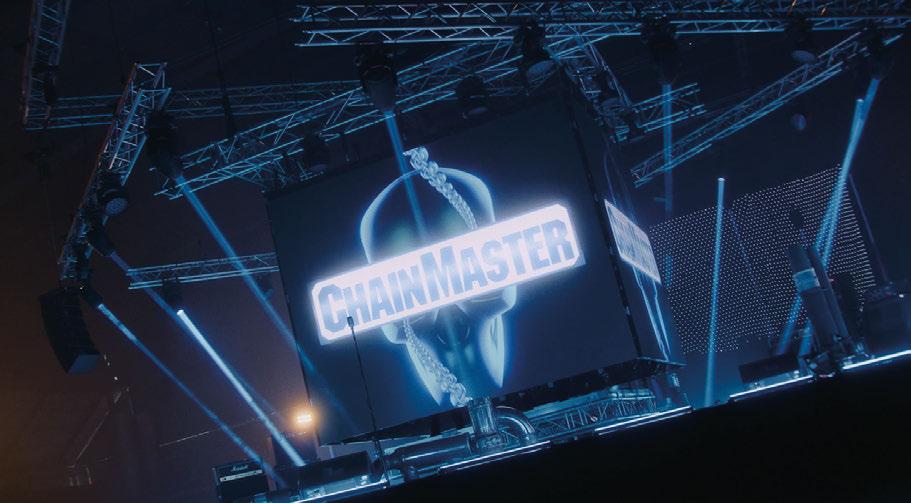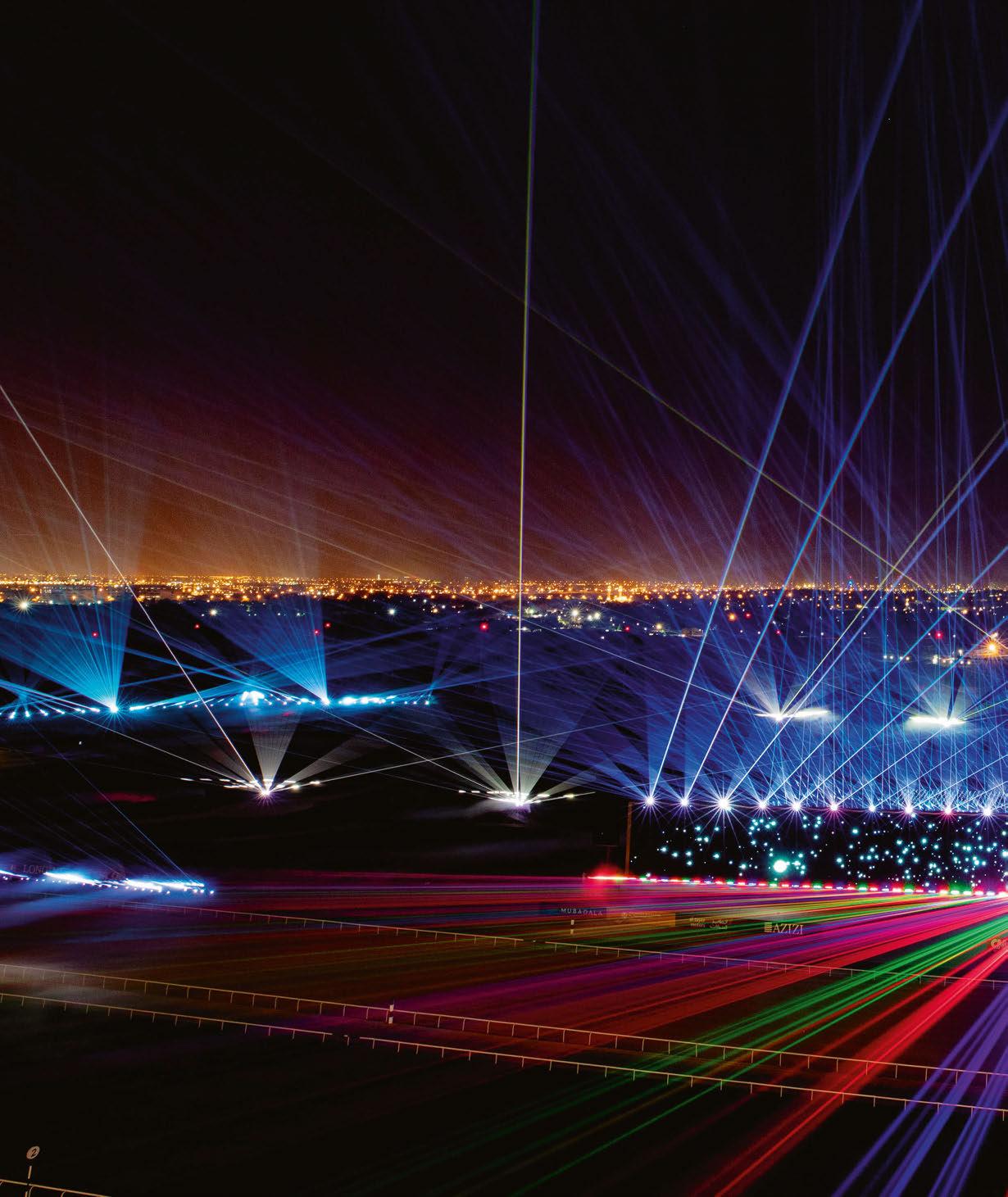
17 minute read
DUBAI WORLD CUP
DUBAI WORLD CUP 2021
A PLANNED AERIAL SPECTACULAR TRANSFORMS INTO A TOUCHING TRIBUTE TO THE LATE SHEIKH HAMDAN BIN RASHID AL MAKTOUM.
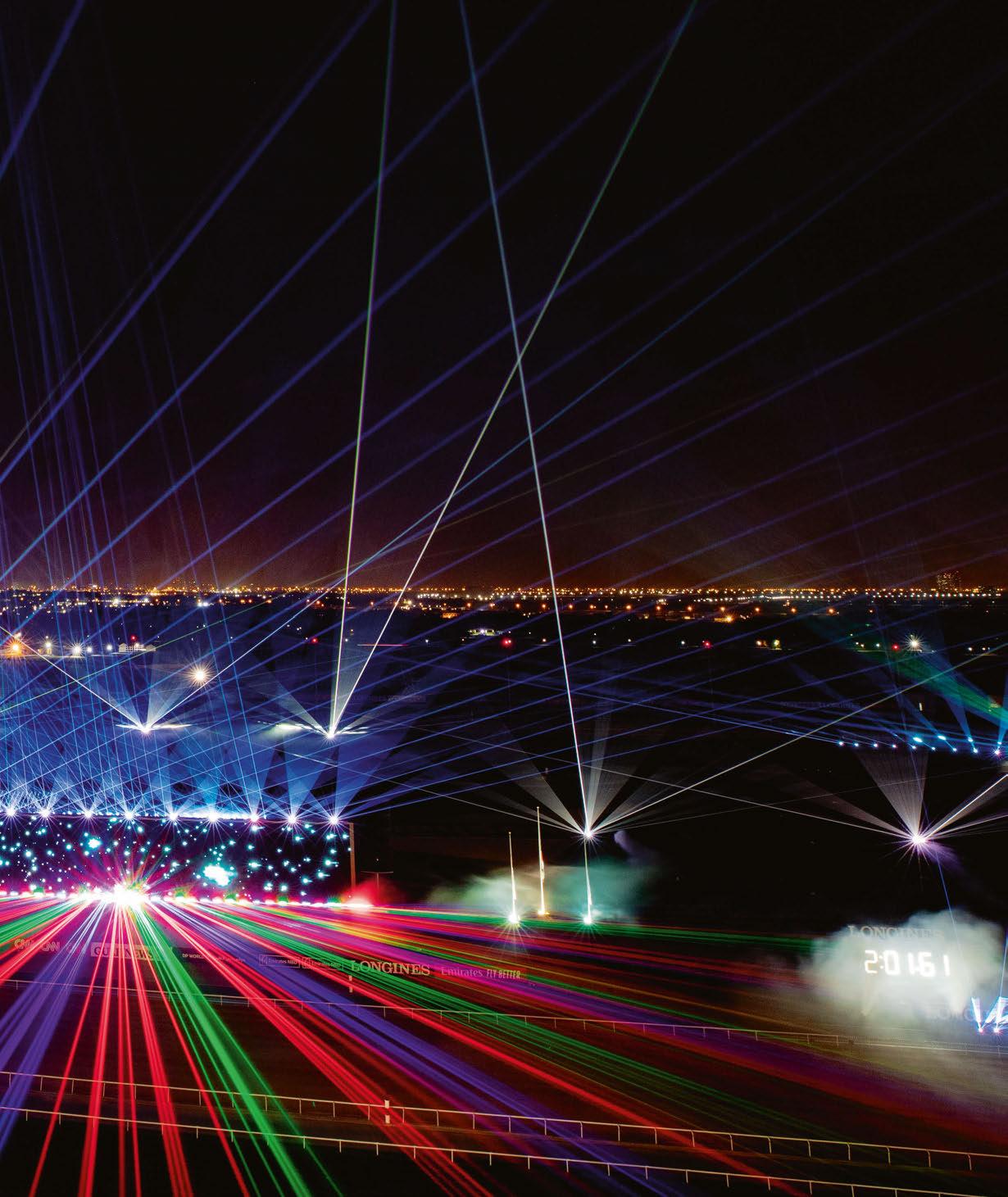
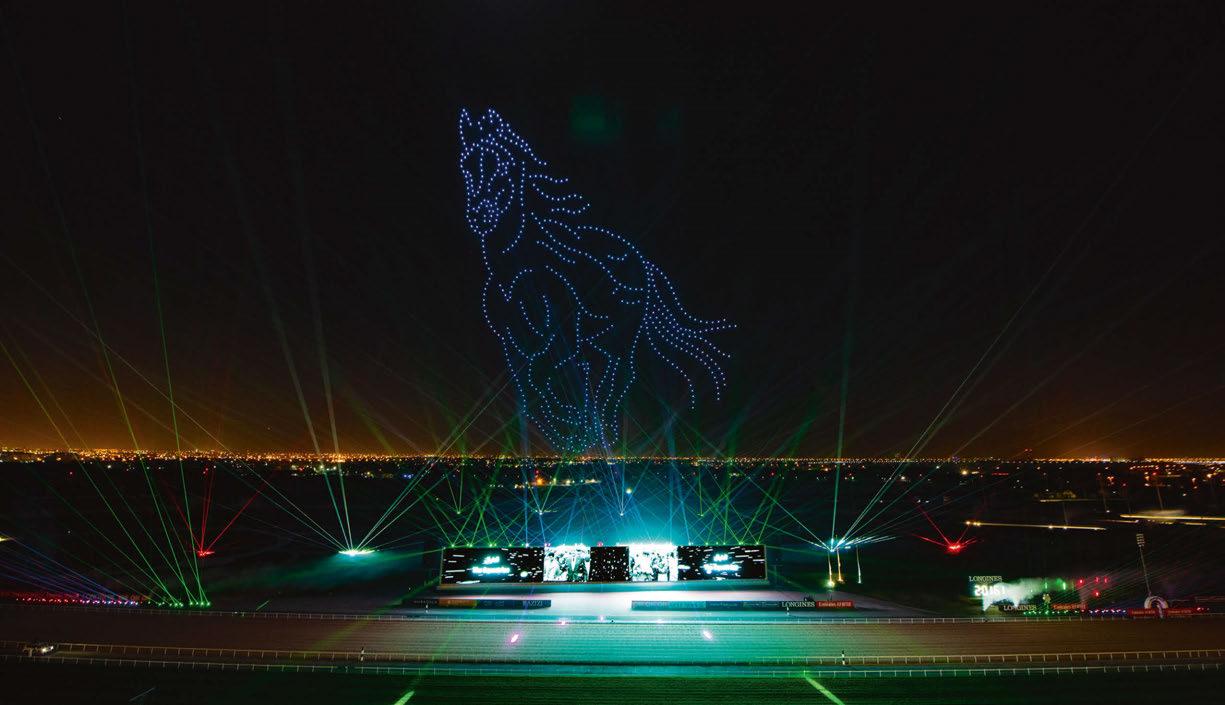
First held in 1996, the Dubai World Cup is a UAE institution. With 2021 being the 25th anniversary of the famous horse racing event, organisers Dubai Racing Club wanted a truly remarkable show to mark the illustrious milestone. The company that was chosen to step up to the challenge was HQ Worldwide Shows (HQWS) – winning the tender with a pitch for an aerial spectacular, complete with aerobatics, pyrotechnic drones, fireworks and a Guinness World Record-breaking laser show. However, just three days before the event, His Highness Sheikh Hamdan bin Rashid Al Maktoum, UAE Minister of Finance and Deputy Ruler of Dubai, sadly passed away at the age of 76. As tributes and condolences poured in from all over the world, Dubai entered a 10-day mourning period, and the status of the Dubai World Cup was in doubt.
“At that point, we had no idea if the event was going to go ahead or not,” recalled HQWS Director of Creative and Design Services, Daz Jamieson. Nevertheless, after careful consideration, it was decided that the Dubai World Cup would, in fact, go ahead in honour of the late Sheikh Hamdan, who was an avid lover of horse racing, owning and breeding racehorses that celebrated many victories at the Dubai World Cup. “We then had to prove that we could transform the show into a touching tribute, instead of the planned aerial spectacular,” Jamieson revealed.
For the planned show, HQWS had called upon a range of trusted suppliers, including ER Productions for lasers; Protec for lighting and audio; Geoscan for drones; pyro and fireworks specialist, FLASH ART; and Creative Technology (CT) Middle East, which delivered comms, audio transport infrastructure, video playback solutions and a complete camera package.
Three days out from show day, all the lasers, lights, audio, pyrotechnics and fireworks were in position, the video content and drone show had been programmed and the aerobatics planes had arrived from the UK. “Everything was in place and we were scheduled to go into dress rehearsals, but then we got the terrible news,” Jamieson recalled. “We had to go back to the drawing board and redesign the entire show.”
With just 72 hours to devise and programme the tribute, the pressure was well and truly on. “All the heads of department on the project came together and talked about how we could work with what we had to transform the production into a beautiful tribute that everyone could be proud of,” explained HQWS’ Louay Al Qaissi, who was both a Project Director and Show Caller on the event.
Thankfully, the majority of suppliers were able to alter their delivery to meet the conditions of a tribute. The only exception to this was FLASH ART, since large-scale pyrotechnics were deemed inappropriate for the sombre occasion. However, according to Al Qaissi, the FLASH ART team remained a vital part of the final production.
“All the pyro was in situ on-site and even though we weren’t able to use it, FLASH ART remained with us right up until the final moment on show day. As pyro experts, they were also able to assist us with the pyro element on the drone show,” he revealed. “We’ve had many, many years of collaboration with FLASH ART. Both companies have grown together, and they are our go-to pyrotechnics company.”
‘A PROUD MOMENT’ Historically, the Dubai World Cup has had a large live performance element, with international
artists such as Gwen Stefani, Kylie Minogue and Janet Jackson among the many who have performed over the years. However, with COVID-19 restrictions in place, the HQWS team had planned to take this year’s show in a different direction. “The live performance element would naturally entice people to gravitate towards the stage – something that isn’t really conducive to social distancing,” Jamieson explained. “So, guided by the client, we went in the direction of an aerial spectacular.”
With that in mind, lasers were a central element of the show design, and for HQWS, there was only one company that could supply the level of laser show required. “We’ve always wanted to do something with the ER Productions guys,” Jamieson revealed. “As soon as it was clear that we’d be going for the Guinness World Record for the most lasers assembled in any one place, they were the natural choice to bring onboard.” Already the Guinness World Record-holder for the largest laser show ever assembled for their spectacular 822-laser show at LDi in 2017, the ER Productions team were happy to be given the opportunity to break their own record at the Dubai World Cup.
“When we started looking at the numbers of lasers involved in the spec, we soon realised that we weren’t far off breaking the record,” explained ER Productions Project Manager, Mark Payne. “Once that was on the table, there was no turning back from that point. We ended up breaking our previous record, with a total of 824 lasers.”
Joining Payne on the core ER Productions team were Laser Programmer, Tom Vallis; Laser Technicians, Harry Boyde and Alex Oita; and Operations Manager, Gary Cornman.
“We also hired four local crew who worked directly for ER Productions, as well as 10 guys from Gulf Crewing, who were excellent,” Payne revealed. “Between the 18 of us on-site, we had plenty of labour.”
Work on the project began long before the team arrived in the UAE, with every aspect of the show meticulously designed in wsywig and visualised in Syncronorm Depence2. Once the design had been finalised, the ER Productions team spent a week prepping all the kit in the UK, ready to be freighted to Dubai. “Every laser is tested and labelled with the position on-site where it’s going to be deployed,” explained Vallis. Payne added: “The work done in the warehouse really was crucial to the success of the project. Tom did a fantastic job in overseeing that.”
The time spent preparing the lasers meant that once they had arrived on-site, courtesy of EFM Global Logistics – “they were excellent, as usual” – all the team needed to do was shuttle the fixtures to the appropriate locations and connect everything up. “As soon as we
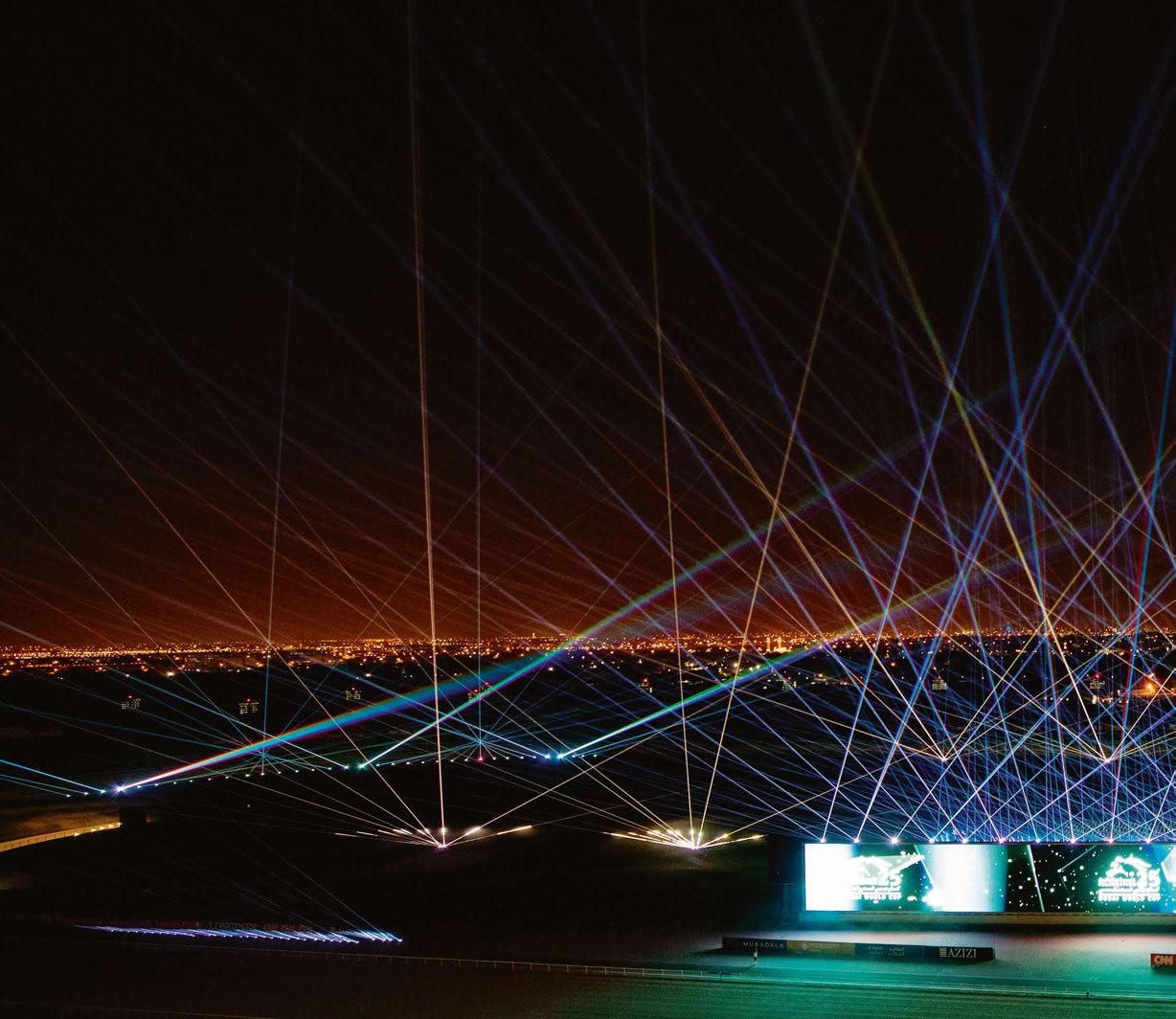
connected everything and powered it up, everything worked perfectly,” Payne commented.
The PM explained how the ER team had built in some extra time to the schedule to account for any delays relating to COVID-19 protocols, so they actually managed to get the system installed a day earlier than planned. “This ended up working in our favour, as it gave us time to work on reprogramming the show to make it appropriate for the tribute.”
Turning what was supposed to be a celebratory and spectacular laser show into a solemn tribute with just three days’ notice was not an easy task. “It was a huge challenge, because lasers by their very nature are not really the ideal tool for a tribute or a sombre occasion such as this,” Boyde supposed. “However, we found ways to make best use of the lasers, focusing primarily on slow, static looks instead of fast, ‘stabby’ stuff.” The Technician explained how the music for the tribute was “quite a slow and melodic piano track” which, again, is not the typical music to accompany lasers. “It wasn’t easy, but we managed to come up with something that suited it well in the end.”
With lasers, lighting, video and drones all combining to form the visual elements of the tribute, Boyde explained that close collaboration between all departments was critical. “For example, when the drones were rising, I programmed twinkling patterns to complement them, then once the drones were in formation, I muted some of the lasers to make sure the drone visibility was maximised,” he described. “It was the same with lighting and video content. Everything had to match up,”
Unsurprisingly, the entire show was timecoded. “That is how we like to roll with lasers,” said Vallis. “You can, of course, do things manually, but when there’s so much going on, and when we have set audio and video elements, it’s the perfect kind of show to utilise timecode. Once it’s all locked together, everyone knows exactly what the show is going to look like.”
Reflecting on the achievement, Vallis described his satisfaction at how smoothly the final product came together. “Considering the circumstances, this could very easily have turned into a bit of a nightmare,” he noted. “However, thanks to the hard work of everyone involved, everything ended up running incredibly smoothly and coming together really well.”
For Boyde, breaking the Guinness World Record is something that will live long in the memory. “It is a great achievement and something that I’ll remember forever,” he smiled. “Getting to programme and operate a show on that scale was a very proud moment for me. Even though the content of the show changed at the last minute, I still think that it looked
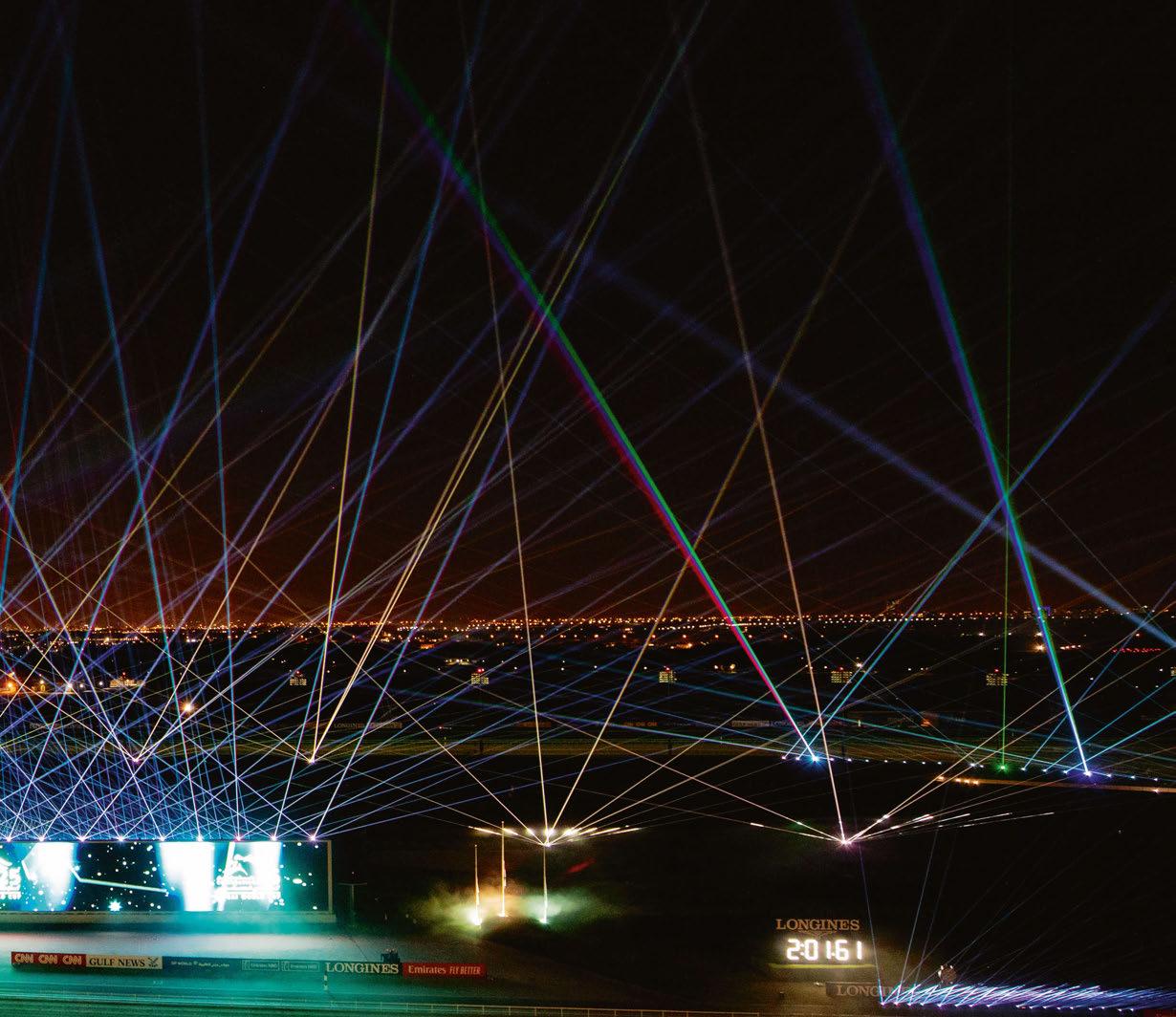
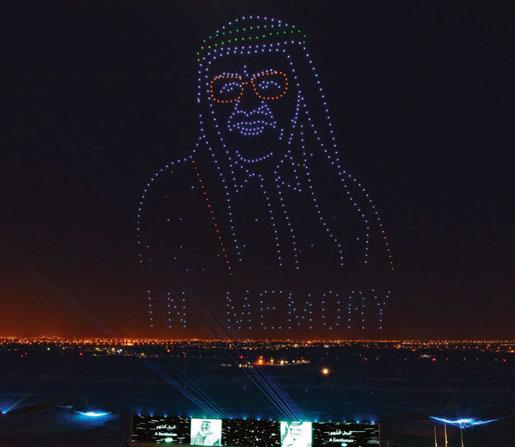
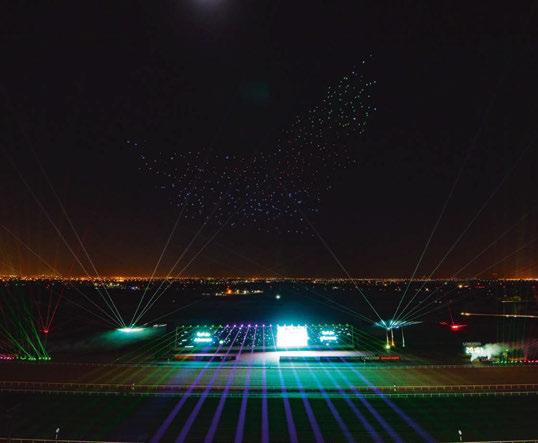
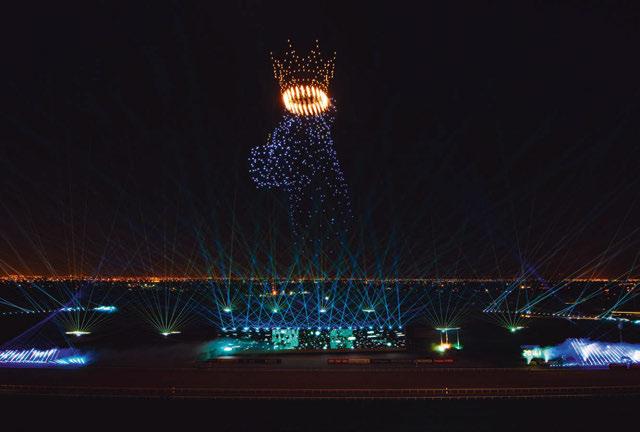
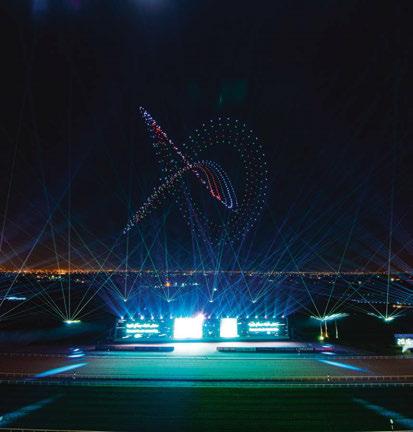
fantastic.” Payne concluded by praising the work of HQWS. “They were excellent. Communication was fantastic throughout; they were in control of every aspect of the show, everything was planned to perfection, and they delivered everything for the event to be a success,” he commented. “I wouldn’t hesitate to do another show with them.”
‘FIGHT FIRE WITH FIRE’ While the record-breaking laser show grabbed the headlines, lighting was also central to the look of the production. With this in mind, the HQWS team specifically requested Lighting Designer, Aaron Russ to head up the lighting team. Russ explained how his aim with the lighting setup was to accentuate the laser show and provide some low-level laser-type effects of his own. To that end, the LD specified 30 SGM Q-7s and 72 Claypaky Xtylos – a fixture with its own RGB laser source. “I chose the Xtylos as they needed to cut through all the laser heads,” he commented. “So, why not fight fire with fire?”
The fixtures were arranged in three even clusters – “one on top of the main world screen and the other two either side at track level,” Russ noted. “The positioning was chosen so I could fire low into the audience to make some nice fill-in looks, as the lasers were aimed high for obvious health and safety reasons.” Control meanwhile came from two MA Lighting grandMA3 full size consoles tuning in Mode 2.
While the lasers were programmed in Syncronorm Depence2, Russ programmed the lighting in wsywig, meaning that “tying the lighting in with the lasers and making it all look coherent” was the most challenging aspect of the project. However, the LD had a solution: “I used a little two-channel vision mixer that I had lying around my studio. I took both inputs and keyed them into each other on one display. Then, by moving our viewpoints around, we could overlay both systems into one harmonious big screen and see exactly how the two elements would look from the comfort of the production village.”
Of course, like all departments, lighting had to adapt quickly due to the changing nature of the show from a celebration to a tribute. “All the fixtures and positioning remained the same as they were already in place ready for dress rehearsal, but we had a manic few days of offline
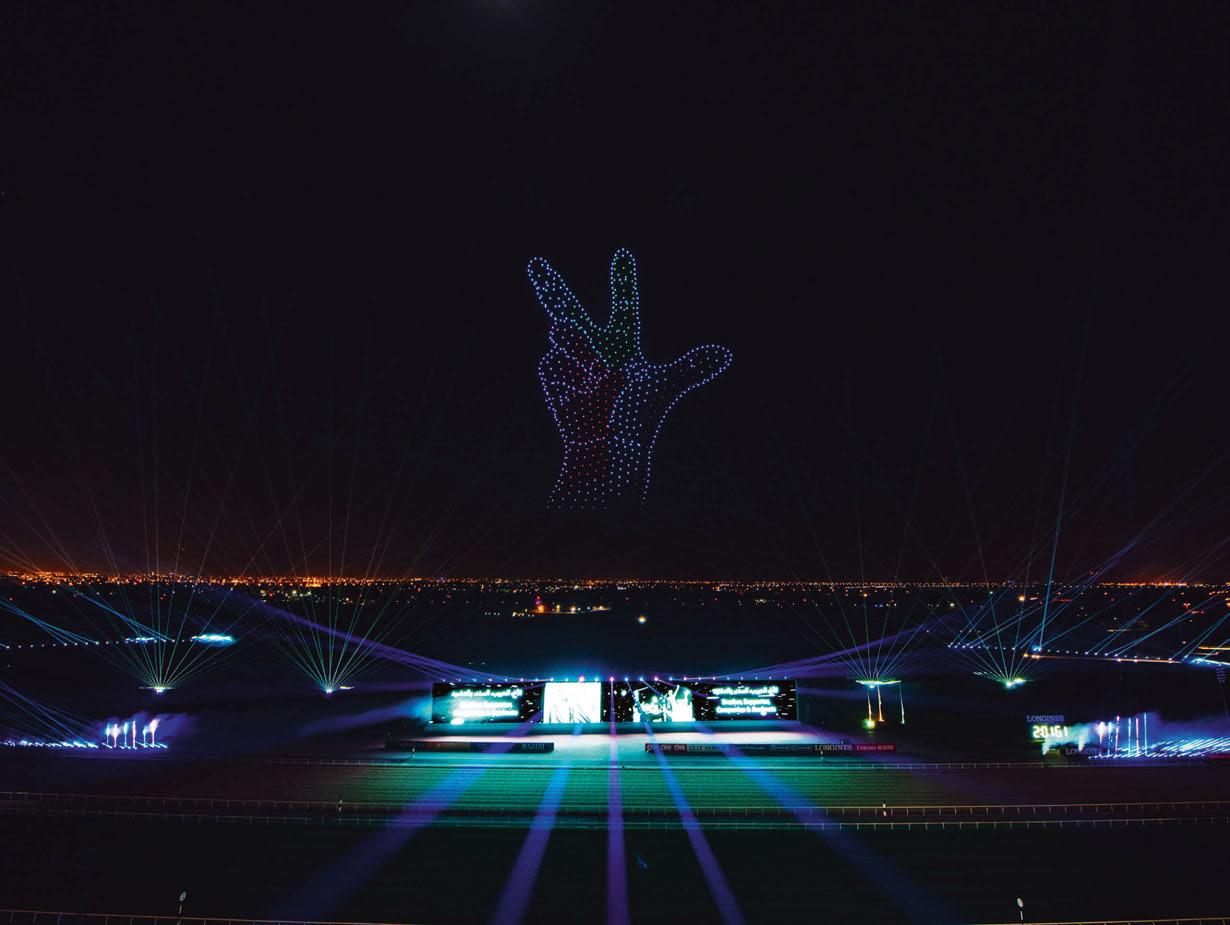
Lighting Designer, Aaron Russ.
programming in the pre-vis suite to get it done in time,” Russ commented. “We made it work though, and in the end, we were really pleased with how well the lighting and lasers worked together. We came up with some absolutely massive looks.”
‘MASTODONS OF THE INDUSTRY’ The drone show element was provided by Geoscan. Representing the Russian company’s first collaboration with HQWS, the project was a landmark moment for CCO, Andrei Golenev. “We had never worked with HQWS before, but I constantly followed them, and I believed that sooner or later we would be able to work with these mastodons of the industry,” he said. A total of 800 drones, including 25 specially adapted pyro models, were utilised for the project. “Pyro drones are a fairly new service. The task of the pyro drones was to raise several fountains and simultaneously ignite them at a certain time,” Golenev explained, adding that they had developed a new body and mounting system for the drones specifically to cater to this requirement. “The main difficulty was that pyrotechnics have different characteristics in different countries,” he added. “However, thanks to the help of the pyrotechnic team, we found the key to solving any issues.”
The final tribute saw the drones fly in several striking formations, including a galloping horse, a horse with a pyro crown, the iconic three-finger hand gesture coined by Sheikh Mohammed, and even a portrait of the late Sheikh Hamdan.
Recalling “sleepless nights” during the lastminute reprogramming of the project, Golenev praised the staying power of all involved. “It was an endless stream of negotiations,” he said. “Each team was immersed in the process of the other and tried to find the solution for all elements of the show to come together perfectly. I think we achieved what we wanted.”
The CCO puts the success of the project down to “the incredible team spirit”. He commented: “It’s only thanks to teamwork that we were able to achieve this. It really motivates and gives strength, even when you are at the limit.” For Golenev, the experience was a
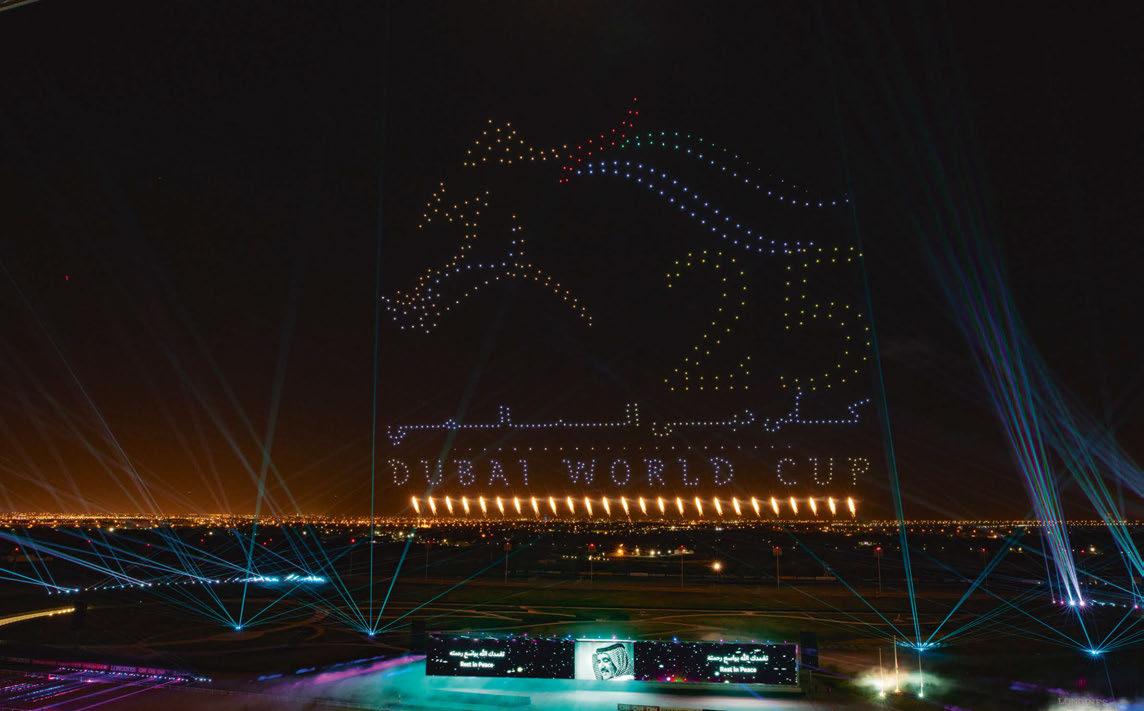
universally positive one. “I have not worked in a more professional and at the same time friendly atmosphere than in collaboration with HQWS,” he concluded.
Jamieson added: “The Geoscan team were a pleasure to work with. Their willingness to make it work with pyro drones was what swung it for them. We’d been aware of what they do for quite some time and we were waiting for the right opportunity to be able to work with them. We’ve found a great new partner with them.”
‘A CLEAR AND STRONG MESSAGE’ The audio department for the event was headed up by Freelance Audio and Communications Consultant, Andy Jackson. The main PA system was designed using a mixture of L-Acoustics large and medium format loudspeakers, including K2s, KARAs and X12s, as well as SB18 and SB218s.
“For the main Apron Area, four 12m single mast towers were placed with a total of 32 K2s and 123 SB218s,” Jackson described. “For the VIP Grandstand, four decks with three K2s and two subs were used. Finally, in the Paddock/Parade Ring, we used eight KARAs, four SB18s and eight X12s.” The Royal box system was based on two Syva and Syva Lows as well as four 5XTs. “The systems were zoned to ensure immediate muting if required,” Jackson added.
The system backbone was based on using a combination of “in-house fibre”, with the system running on Dante through Glensound DARK88ii boxes. Control came via a DiGiCo SD5 with two SD racks and two Mini Racks, while all presenter RF was Shure Axient, with Sennheiser 2050 IEMs.
Jackson revealed that he made some minor adjustments to the setup, deploying additional loudspeakers to cover the Paddock areas once it became clear that the event would be a tribute featuring a poem written by Sheikh Mohammed on the day of his brother’s death. “This was due to the fact that I wanted everyone to really embrace the voiceover element of the tribute, as this carried a very clear and strong message,” he explained. “I wanted to personalise this as much as possible.”
Al Qaissi added: “The poem worked very well and was incredibly powerful. It still gives me goosebumps every time I hear it. It was such an emotional way to start the show.”
The number one consideration for Jackson was ensuring full coverage for the socially distanced audience while being mindful of any possible disturbance to the horses. “The system had to cover the entire grandstand, which is around 800m long, as well as all the corporate boxes. The audience was socially distanced, so, effectively, we needed to deploy a ‘full coverage’ system for around 5% of the guests,” he said.
“I used a similar design to previous years, placing all the loudspeakers on the audience side of the track. This ensured that we could zone the system efficiently, avoid disturbing the horses, and also avoid any sync delay timing issues with the screen, which was over 100m away from the grandstand. It was vital that we worked closely with HQWS and Dubai Racing Club, so as to minimise any impact outside of the show.”
The project came at a busy time for Jackson, who has found his skillset and vast experience in high demand since he left PRGdeltasound at the start of the year. “Since leaving PRGdeltasound in January, I have been extremely lucky to consult on various projects, including integration and live projects,” he revealed. “I’ve also taken a step back, allowing me time to focus on other interests.
“The Middle East has taken steps to ensure safe and monitored events throughout the
pandemic, and I believe the region will recover faster than many others around the world.” Clearly proud of the project, Jackson concluded: “It was fantastic to see the incredible teams of creatives and technicians back out, doing what they do best – delivering shows.”
‘HATS OFF TO CT’ Creative Technology (CT) Middle East’s supply comprised a complete camera package, video playback solutions, communications and audio transport infrastructure. Due to the size of the main grandstand and track area, CT utilised the venue’s in-house fibre, SMPTE patch for all cameras, and network connectivity. The company’s team of network professionals cleaned and proved all the lines before they were used in advance of the event.
For the comms, CT used a Riedel artist 64 frame as its matrix, Bolero wireless belt packs for the event’s remote users and Clear-Com HelixNet was deployed throughout the venue through Luminex 14r and 26i switches, which also carried the data for the Riedel DSP-2312 user panels. A total of 60 Motorola handheld portable radios were used, along with eight SLR5500 repeaters to interface into the communications system.
“Our new Glensound DARK88ii units enabled us to transport the audio and timecode signals to various parts of the venue from the audio control position,” explained CT Integrated Network Technical Manager, Rob Turner.
Video playback was controlled through a 5K pixel base Dataton Watchout playback system and Barco E2 graphic mixer. “We also provided a seven-camera PPU package with a combination of RF and wired cameras,” said CT Head of Engineering, Tom Stocks. “Our cameras were placed remotely across the site, ensuring full coverage of the race and closing tribute.”
CT also provided infrastructure and distribution to integrate video feeds to and from local broadcast trucks and drone cameras. “Remote control panels were supplied to key members of the production team, allowing them to view individual cameras and multiviewers around the site in various control locations,” Stocks added. “The final PPU mix was processed in our E2 screen management system to apply the creative masking for the IMAG screens.” Turner concluded: “It was an honour to be part of this fitting tribute for the late Sheikh Hamdan bin Rashid Al Maktoum. The race day and tribute went very well, and it was great to be back on site. Our client, HQWS, and Dubai Racing Club, created a safe and COVID-19 secure environment with the greatest of professionalism, and made this DWC a joy to work on.” Al Qaissi added: “Thank you to the CT team for being phenomenal with the delivery of DWC2021 on behalf of the HQWS team. Having them on-site made our lives so much easier. Hats off to CT!”
Jamieson concluded by giving his final thoughts on the project. “With everything that happened in the build-up, this really could have gone either way, but we feel that the emotion that we generated was exactly what was needed and a fitting tribute to the late Sheik Hamdan. The feedback so far has been incredible. We’re really proud to have delivered this historic project.” Photos: HQWS www.hqws.com www.er-productions.com www.geoscan.aero www.ct-group.com
YOUR PARTNER FOR STAGE & STUDIO LIFTING EQUIPMENT
